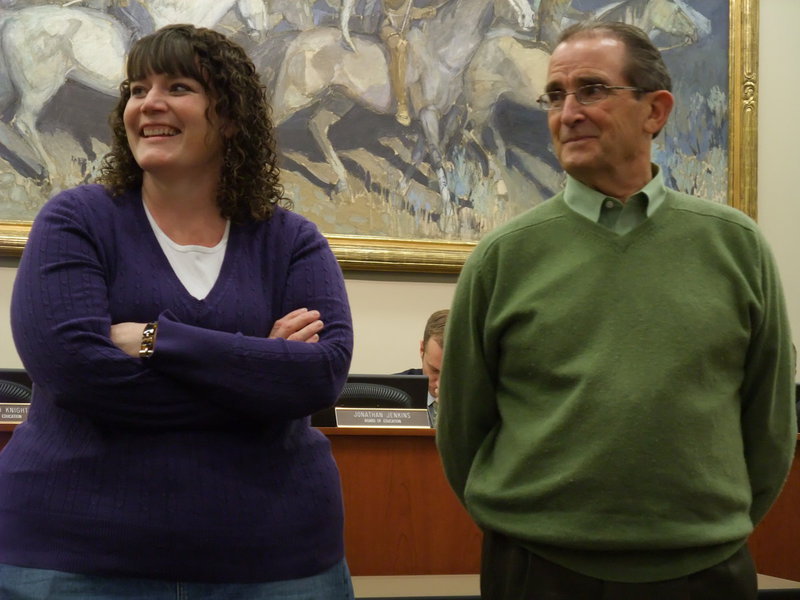Academic standards moving up a grade for Cache schools
Kelly Garcia and Jim Payant — The State of Utah honored two Cache County School District employees with awards. Kelly Garcia received the 2010 Early Childhood Special Educator of the Year and Jim Payant received the 2010 Early Childhood Special Education Administrator of the Year. (Dave South)
Big changes are coming for students of the Cache County School District. Over the next four years the district will implement new core curriculum standards that will change the very structure of how students are taught. Gone are the separate classes of Algebra, Geometry, Algebra II and Pre-Calculus. In it’s place will be high school math courses designed to interleave all these concepts together and build on them during each successive term.
Craig Ashton, Curriculum Director, presented these changes during the Cache County School Board meeting Thursday evening. Ashton said this is part of a multi-state effort to raise student performance.
“Some people think these standards are federally driven,” said Ashton. “This is not the case. These standards are state driven.”
In all, 40 states are working together to build a common standard for education. In creating the new curriculum, researchers looked for the best examples of education from all over the world — from high performing schools in the U.S. to the best schools in Asia and Europe. They merged the best of all these sources into one document.
The goal is to overcome the real-world problem of graduating high school students being unprepared to enter the workforce or college. Ashton reported that students who do well in high school, have great GPAs, and graduate with honors are still having to take remedial programs when they enter college.
There is a gap between what’s expected at high school graduation versus new college freshmen.
This gap was illustrated by Holly Peterson, Secondary Literary Coordinator, when she presented the arts and literature portion of the new curriculum.
Peterson said that since 1962 the books used for K-12 schools have become simpler. However, the complexity of reading materials in college and in the workforce have become more complex. The measure of reading complexity is called a Lexile. For college and workforce texts the common complexity level is around 1200 to 1400 lexiles. However, the final reading complexity of most 12th grade requirements is 1130 lexiles.
“This equates to a two to three year difference in reading ability,” said Peterson.
This gap cannot be overcome with a simple improvement to one or two English classes. Instead, the new curriculum will focus on four “strands” — reading, writing, listening, and speaking — taught throughout all curriculum including history, social studies, science and technical classes.
More emphasis will be given to informational reading and texts as the students progress through the class work. At fourth grade the split between literature and informational reading will be 50/50. By high school the split will be 30 percent for literature and 70 percent for informational texts.
Writing will also be boosted with more emphasis on argumentative, informative and narrative writing. Like reading, all curriculum in the school will interleave these concepts in all assignments.
School board member Richard Knight asked Peterson about whether the textbook manufacturers will actually change direction and produce the texts we need. She said that 40 states are signing onto the new curriculum. If the publishers want to sell books, they need to step up as well.
Ashton said that two states are leading the way for adopting the new standards — Utah and Oregon. Utah has adopted the International Pathway. The goal is to create a world-class education system in Utah where graduating seniors are qualified to step into any university or workplace.
More concepts of the new program:
- Students are basically accelerated a grade level compared to existing programs.
- Instead of teaching and forgetting a concept, all concepts are continually taught and built on throughout a class and in subsequent classes.
- It will take two to three years to implement the program.
- The state will be testing all students in the new curriculum starting in 2014.
- Testing standards will be uniform across the 40 states allowing a near-national comparison of student performance.
- The international pathway chosen by Utah will also allow better comparison of student performance with other high-performing countries.
This is not an easy program to implement. The teachers will need to go through new training to teach the new courses. Textbooks, tests and materials will need to be changed. Superintendent Steven Norton asked the board to consider adding back teacher professional days. These days, used by teachers for continuing education, were cut so the district could make the tight budget this year. If possible, Norton is asking that they be reinstated next year to help the teachers with the transition to the new materials.
Editor’s Note: Tonight the school board recognized the teachers of the year for the district elementary schools. They also recognized the state awards given to two very special educators in the special education program (yes, that was on purpose). I want to add that my child was taught by Ms. Kelly (as he called her) and she changed his life. Jim was a big part of that, too. Thank you both for all that you do.

